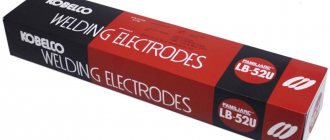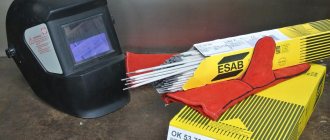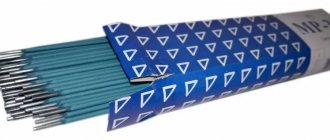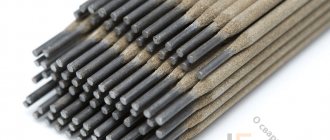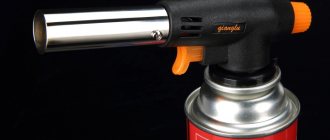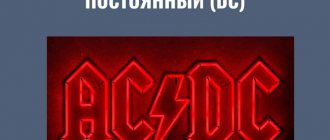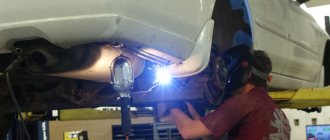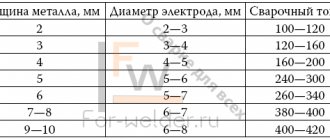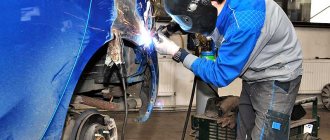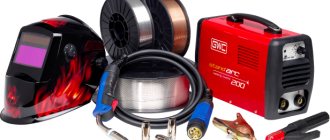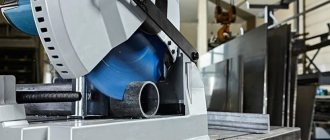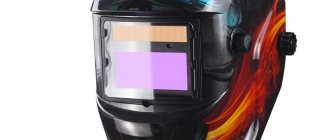| Place | Name | Characteristics in the rating |
| The best welding electrodes with basic coating |
| 1 | ESAB UONI 13/55 (350 x 3.0 mm; 4.5 kg) | Best price for basic electrodes |
| 2 | KOBELCO LB-52U (350 x 3.2 mm; 5 kg) | The best combination of price and quality |
| 3 | QUATTRO ELEMENTI 771-374 (350 x 2.5 mm; 0.9 kg) | The best combination of mechanical characteristics of the electrode metal |
| 4 | ESAB FILARC 88S (350 x 2.5 mm; 7.2 kg) | High quality of the resulting welded joints. Special Series |
| 5 | “KEDR” E 308L-16/OZL-8 (350 x 3.2 mm; 2 kg) | The best basic coated electrodes for welding high alloy steels |
| The best rutile coated welding electrodes |
| 1 | ESAB OK 46.30 (450 x 5.0 mm; 18.9 kg) | The most economical electrodes |
| 2 | Quattro Elementi 772-166 (300 x 2.0 mm; 3 kg) | High degree of popularity |
| 3 | "Resanta" MR-3S (350 x 3 mm; 3 kg) | The most favorable price offer |
| 4 | Inforce MP-3 11-05-01 (450 x 5 mm; 5 kg) | Balanced mechanical performance |
| 5 | ELITECH MP-3C (350 x 3 mm; 5 kg) | Optimal combination of price and quality of the deposited layer |
| Best Cellulose Coated Welding Electrodes |
| 1 | ESAB Pipeweld 7010 Plus (350 x 4.0 mm; 20 kg) | Good resistance of electrodes to overheating |
| 2 | "SpetsElectrode" MP-3S (450 x 4 mm; 5 kg) | High welding conditions without preliminary metal preparation |
| 3 | "Monolith" RC ANO-36 (4 mm; 5 kg) | Best price |
| Best Acid Coated Welding Electrodes |
| 1 | ESAB OK 67.71 (350 x 3.2 mm; 4.8 kg) | Wide range of applicability. High quality welds |
| 2 | ESAB OK 61.20 (30 x 2.5 mm; 4.2 kg) | Optimal cost parameters |
Welding electrodes are a mandatory consumable material used during welding operations. Its essence lies in introducing additional (electrode) metal into the weld pool formed when the base metal melts in the weld zone. The result of this action will be a permanent connection capable of absorbing various types of loads and ensuring rigidity or tightness (in the case of pipe welding) of the structure.
Simple in words, in reality this process requires a fair amount of preparation, including in terms of selecting electrodes. It is not enough to select a consumable element with a metal whose properties are as close as possible to the main one. The market is gradually filled with competing products, so even professionals, let alone novice users, often fail to make the right choice in such an environment. After studying reviews from consumers and experts, we have prepared for you a rating of the best welding electrodes, divided into four main categories.
The best welding electrodes with basic coating
Electrodes with a basic coating are used quite often, since they do not impose strict restrictions on welding. The parts to be welded can be oriented in space at any angle - the electrode works in all spatial positions. In addition, not only thin metal products can be subjected to the process of obtaining a permanent connection - thick sheets of metal and thick-walled structures are also subject to welding with the main electrode. The only condition: these processes must take place at a constant current of reverse polarity.
Which electrodes to choose for welding
Electrodes brand UONI 13/55
These products are used for inverter welding using DC current. They have proven themselves in places where particularly high quality connections are required. The formation of a weld pool provides protection from the negative effects of oxygen contained in the air. Its effect is neutralized by carbon dioxide released during the combustion of the coating.
Such coating creates some inconveniences at the moment of ignition of the product. This takes a lot of time for young welders. Difficulties also arise with re-ignition due to the strong hardening of the coating insulating the tip of the metal rod. However, these minor flaws are compensated by beautiful seams, without any slag marks.
Products Kobelco LB-52U
Expensive Japanese electrodes for inverter, characterized by high quality. One package holds 4-5 kg of products.
Despite the high price, they are in wide demand, especially when it is necessary to weld low-carbon steel. They are literally indispensable when double-sided boiling of workpieces is impossible. It is these electrodes that are used in pipeline connection work. The result is durable seams with a guarantee of quality.
The electrode rod, as in the previous case, is covered with coating. Before starting work, the products require calcination at temperatures up to 300 degrees. After removing moisture, combustion improves significantly, and the seams are of better quality, both horizontally and vertically. In most cases, work is carried out with direct current. It is possible to use alternating current, but the quality of welding will be slightly reduced.
Brand OZL-8
Domestic electrodes for welding, designed to work with steel workpieces containing large quantities of chromium and nickel. These are the electrodes chosen for welding stainless steel. The only limitation of these products is their use in devices with direct current and connection in reverse polarity. Due to this, a short arc of the required size is obtained.
If all technology requirements are met, very durable seams are obtained that are not susceptible to corrosion.
This is very important when welding parts under constant loads.
A certain inconvenience is the appearance of slag in small quantities, which is quickly and easily separated from the surface of the workpiece. When cooled, the seams do not crack, but sudden cooling should be avoided to avoid crystallization, which reduces the strength of the joint. Before use, such electrodes require calcination.
Welding cast iron with an electrode at home
Polarity when welding with an inverter
How to cook with an inverter: tips for beginners
Welding copper wires with an inverter using carbon and graphite electrodes, and the spot method
Welding stainless steel with an inverter
Contact welding from an inverter
The best rutile coated welding electrodes
Rutile electrodes have gained great popularity among welders due to a combination of useful characteristics. They have easy ignition, are highly resistant to moisture, and can also be used on direct and alternating current. Their disadvantages include the impossibility of welding structures made of high-carbon steel, the direct dependence of the quality of the seam on the welding modes, as well as the need for careful preparatory operations (such as drying and calcination of the surface).
Suitable brands
When deciding which electrodes to choose for welding with an inverter, you can look at the statistics, which will show the most popular options. Among them are:
UONI-13 55 - they are more suitable for welders with experience. They serve to create a tight seam that is highly durable. They can be used even at low temperatures.
Electrodes for welding with inverter brand UONI-13 55
MP-3S - can become an indispensable solution in cases where high quality requirements are put forward for the seam. They are suitable for direct current with reverse polarity and for alternating current.
Electrodes for welding with MR-3S inverter
MP-3 is a universal brand, since the rod is suitable for most required operations. They can be used in any conditions, even if the metal surface is contaminated with something, including rust. They resist moisture well and protect the seam from hydrogen ingress.
Electrodes for welding with MP-3 inverter
ANO - the series consists of several brands, but overall it is the most popular in use. Their advantage is that the electrodes do not need to be pre-pierced. The arc ignites well both the first and subsequent times. The quality of the seam is quite high. Suitable for beginners.
Electrodes for welding with ANO brand inverter
Features of choosing an electrode for an inverter depending on the conditions of the metal being welded
When wondering how to choose electrodes for inverter welding, you should first find out what exactly you have to weld. When selecting consumables for steels, you should know their composition. A very important point here is the level of their alloying, what additional elements are included there and in what quantities. The fact is that if stainless steel is welded, then after the process itself, when the wrong choice is made, the stainless steel itself loses its anti-corrosion properties and rust may appear at the weld site over time. To prevent this from happening, it is necessary to select electrodes that will compensate for temperature losses.
Electrodes for welding stainless steel with an inverter
Similar schemes apply to steels with a high carbon content. If, on the contrary, the metal has a low level of carbon, then it is necessary to provide additional protection so that this element does not get into the seam, otherwise the entire connection will become quite fragile. To work with cast iron, you should use special consumables that are designed specifically for this metal, otherwise there is a high risk of defects.
Each metal has its own characteristics in the welding mode, due to the difference in melting point and fluidity properties. If the electrodes are selected from the same composition, then there should not be any big problems with the application, since it is enough to just set the specified parameters that are suitable for the desired position and start working. Thus, when considering which electrodes are best for an inverter, the above factors should be taken into account
Basic modes and nuances of application
Having chosen which electrodes are best for an inverter welding machine, you should familiarize yourself with the modes of their use. Here are the current parameters for all positions for the most common models:
MR-3S
| Diameter size, mm | Current strength, A | Number of electrodes for 1 kg of surfacing, pcs. |
| 2,0 | 30…80 | 94 |
| 2,5 | 50…90 | 53 |
| 3,0 | 70…120 | 38 |
| 4,0 | 110…160 | 19 |
| 5,0 | 150…200 | 12 |
ANO-21
| Diameter size, mm | Horizontal welding, A | Vertical welding, A | Ceiling welding, A |
| 2 | 50…90 | 50…70 | 70…90 |
| 2,5 | 60…110 | 60…90 | 80…100 |
| 3 | 90…140 | 80…100 | 100…130 |
MR-3
| Electrode diameter, mm | Horizontal welding, A | Vertical welding, A | Ceiling welding, A |
| 3 | 100…140 | 80…100 | 80…110 |
| 4 | 160…220 | 140…180 | 140…180 |
| 5 | 180…260 | 160…200 | – |
USENI-13 55
| Diameter size, mm | Position | ||
| Bottom seam | Vertical seam | Ceiling seam | |
| 2 | 40…60 | 40…65 | 40…70 |
| 2.5 | 70…85 | 60…75 | 60…80 |
| 3 | 80…95 | 70…90 | 70…90 |
| 4 | 130…150 | 130…140 | 130…140 |
| 5 | 180…210 | 160…180 | |
| 6 | 210…290 |
What are electrodes?
Welding electrodes are metal and non-metallic rods (cores) chemically coated with electrically conductive material. The rod is used to maintain the welding arc and provide the filler metal needed for the joint being welded. The selection of rods is made in accordance with the materials and aspects of the welding work.
The wire is connected to a current source using equipment. When the chain closes, an arc is created that melts the material. The shell of the rod produces gases that stabilize the arc, counteracting the purge, and prevents oxidation of the weld.
The flux coating on the electrodes determines how it will act during the welding process. The surface layer protects the metal from damage and stabilizes the arc. The filler material is obtained by fusing electrodes in the form of droplets. Protection is achieved by decomposition of the coating in the form of gases and in the form of liquid slag, which floats above the molten pool, after which it becomes solid. Products are manufactured to be within acceptable moisture and seam strength limits.
https://youtube.com/watch?v=jemAcPldLZY
Disadvantages of inverters for manual welding
Like any technology, the inverter also has disadvantages. One of the most significant disadvantages is the presence of special requirements regarding the storage of the device. Proper storage conditions require, first of all, protecting it from dust, which can cause serious harm to the device.
It is precisely because of such requirements for storage conditions that manufacturing companies and construction organizations choose welding machines that are not so sensitive to the state of the external environment. Such devices, which include welding transformers and generators, can be safely left outdoors without worrying that this will seriously affect their technical characteristics. The disadvantage of inverters is their cost, which exceeds the price of welding transformers.
In addition, inverters require appropriate maintenance. In particular, to maintain devices in working condition, they must be thoroughly cleaned and purged after a long period of operation, which is not required by conventional welding transformers.
It is also important to start working on such a device correctly if it has just been brought in from the street. It is important to know that you can connect the inverter to the network and start working with it only 1.5–2 hours after moving it to a warm room
This requirement is due to the fact that condensation accumulates on the elements of the device, brought into the heat from the street, which can cause problems in its operation.
Diametral section
The diameter of the electrodes for pipelines is of great importance. This value affects the consumption of filler material and the properties of the seams.
The nominal diameter is the thickness of the rod without coating. The coating thickness is different for each type of electrode and is regulated by GOST 9466-75.
The coating can be determined by the ratio of the total diameter of the electrode to the diameter of the rod:
- A coating is considered thin if the ratio is equal or less than 1.2.
- Average coverage is defined as equal to or less than 1.45.
- If the diameter ratio is equal or less than 1.8, the coating is thick.
- If the diameter ratio is more than 1.8. That coating will be especially thick.
It is worth noting that imported products must also meet these rules. However, it is rarely possible to note that their diameters comply with Russian standards.
The best budget inverter welding machine Wert SWI 190 (TIG, MMA)
- two types of welding;
- hotstart;
- protection against electrode sticking.
The universal tool leads the ranking of the best budget inverter-type models. The unit operates using TIG and MMA technology. The power is low - 3.5 kW, but the tool is inexpensive - less than 3,000 rubles. The highest current strength is 190 A.
Due to its compactness and lightness (weight less than 2.5 kg), it is appreciated by installers performing high-altitude work. Useful options include hot start, protection against electrode sticking, and the ability to adjust arc force.
The small-sized device is suitable for welding by weight, at height.
What kind of coverage is needed?
There are four main types of coating, each of which has its own distinctive properties.
1. Acid coating is mainly composed of iron, manganese, silicon and other chemical elements. Electrodes with this type of coating are marked with the letter “A”. Advantages of acid-coated consumables: high resistance to the appearance of air channels in the welded joint; the ability to process rusty products and parts with scale. The main disadvantage is the risk of hot cracks appearing in the weld metal.
2. Electrical conductors with cellulose coating are designated by the letter “C”. A special feature is the high content of organic substances (mass fraction can reach 50%): cellulose, organic resins, ferropalms, etc. When burned in an arc, this type of coating releases a large amount of protective gases and a small amount of slag. This guarantees the convenience of welding work in a vertical position. Disadvantages : high hydrogen content when working with steel can negatively affect the characteristics of the deposited metal; significant amount of splashes.
3. Rutile electrodes are marked with the letter “P”. The basis of the coating is rutile, as well as some silicon and oxygen content. This type is characterized by quiet melting, a small amount of spatter, easy slag separation, and the seam has a fine pattern. An important feature is the ease of re-ignition of the arc. Welding work should be carried out in conditions of normal humidity and after calcination of the materials, otherwise the quality of the connection deteriorates and signs of oxidation appear.
4. The main coating of the electrodes is designated by the letter “B” and consists of magnesium and calcium carbonates. Conductors with this type of coating are designed to operate on direct current, as well as for connecting critical structures and pipelines. The deposited metal has an increased level of ductility and is not prone to oxidation. The main advantage is that the low saturation of this type of coating with hydrogen eliminates the deterioration of the characteristics of steel and other metals. The main disadvantage is the formation of a large amount of slag.
How to choose electrodes for inverter welding
When choosing these products, the most important thing is to decide what material you will have to work with.
That is, it is important to know what the products being welded are made of, and the electrode core must match them in composition
Thus, electrodes can be classified according to a number of characteristics:
- for low-carbon metals, carbon options are used;
- for cast iron;
- for strong heat-resistant steels;
- for high alloy metal;
- for working with aluminum or copper versions of products;
- for surfacing and repair work;
- universal options.
Electrodes for cast iron
Electrodes used for work must not be damaged
It is also important that they are dry. Special ovens are used to dry products.
Experienced specialists also take into account the conditions in which the work will be carried out. For example, humidity, ambient temperature, etc.
It is also important to consider the diameter of the selected electrode, the thickness of the parts and the current strength. It is important to understand that if the product is selected incorrectly, the current density can be reduced
As a result, the quality of welding will leave much to be desired, the seam will be thick and wide. Typically, electrode manufacturers immediately indicate for what current strength the product is best suited. For complex and massive structures, it is better to take thick electrodes, while profile products are welded in versions up to only 2 mm thick. We suggest estimating the approximate ratio of metal thickness and diameter using the figure below.
Ratio of workpiece thickness and electrode diameter
And here are the recommended current values depending on the thickness of the product.
Relationship between electrode diameter and welding current
Material properties
The weld metal must have similar toughness and strength as the base metal. Therefore, it is necessary to study the brand of electrodes for pipe welding, which must comply with the DIN EN 499 standard. This document regulates the tensile strength, yield strength and toughness of the weld metal.
For example, electrodes with the designation E 46 3 B 4 2 H5 have the following parameters:
- The letter E denotes electrodes intended for manual welding. You can use such electrodes for welding water pipes.
- Next comes the yield strength indicator, 460 N/mm2 is considered the minimum limit.
- The next designation is the temperature conducive to crack development, -300C.
- B - means the type of coating, in this case - the main one.
- The next number is the applied current. 4 – welding using direct current.
- Next comes the designation of the direction of the seam. 2 – any, excluding vertical.
- The last designation is the amount of hydrogen that the deposited metal may contain. H5 means 5 ml/100 g.
The most popular electrodes in Russia
There are many different ratings of Russian electrodes in Internet sources. They often do not hide the customer of such a rating-review. Basically the word best appears in the title. Although in different hands and different conditions different products will be the best. This article discusses the most popular electrodes. At the same time, the orientation is both on specialized professional sources, including “Welding and Diagnostics”, “Metallurgical Bulletin”, and on reviews of professionals.
The following were selected as the main parameters:
The prices given are for 3 mm electrodes, as the most common.
There are 3 categories of these products in the country:
1. Foreign production. 2. Products of joint ventures. 3. Domestic producers.
It is in this order that the distribution by quality is accepted by everyone. But many experts note a narrowing gap with the best Western examples. At least in terms of such a parameter as stable quality, joint ventures are already very close to them.
These groups are formed according to the main parameter of the welding electrode - the composition of its coating. This quality determines most of the electrode properties: from the most important result in the quality of the seam, to the very important practically - ease of ignition.
The groups are as follows:
• rutile (and of the same family - rutile-cellulose and others); • with main covering (emphasis on the second syllable).
Rutile ones are more universal - they work on both types of current, are less sensitive to dampness, and are used in any direction of the seam. But since there are quite a lot of their manufacturers, you need to choose carefully when purchasing, otherwise you can create a lot of so-called slag ulcers.
Electrodes with basic coating are mainly used for direct current and in particularly critical areas. The specificity of welding with them (the release of carbon dioxide in quantities sufficient to protect the welding zone from oxygen) leads to a more ductile weld, which only the best rutile can achieve. There are two significant disadvantages - it is more inconvenient to work with, since ignition is not easy. And the loss of quality over time is due to a greater reaction to humidity.
Table of the most popular electrodes in Russia
| Coating | Rating | Name | Weldable | ||
| Place | Points | rub/kg | |||
| Rutile | 1 | 9,6 | ESAB-SVEL OK 46.00 | Carbon steel and low alloy steel | 190-225 |
| 2 | 9,5 | Lincoln Electric Omnia 46 | 164-305 | ||
| 3 | 9 | OZS-12 (SpetsElektrod, Moscow) | 150-200 | ||
| 4 | 8,7 | Resanta MP-3 | 160-200 | ||
| Basics | 1 | 9,5 | Kobelco LB-52U | 450-500 | |
| 2 | 9,1 | OZL-8 (LEZ) | Stainless and anticorrosive. steel, with nickel and chrome | 500 | |
| 3 | 8,9 | SSSI 13/55 | Carbon steel | 130-200 | |
